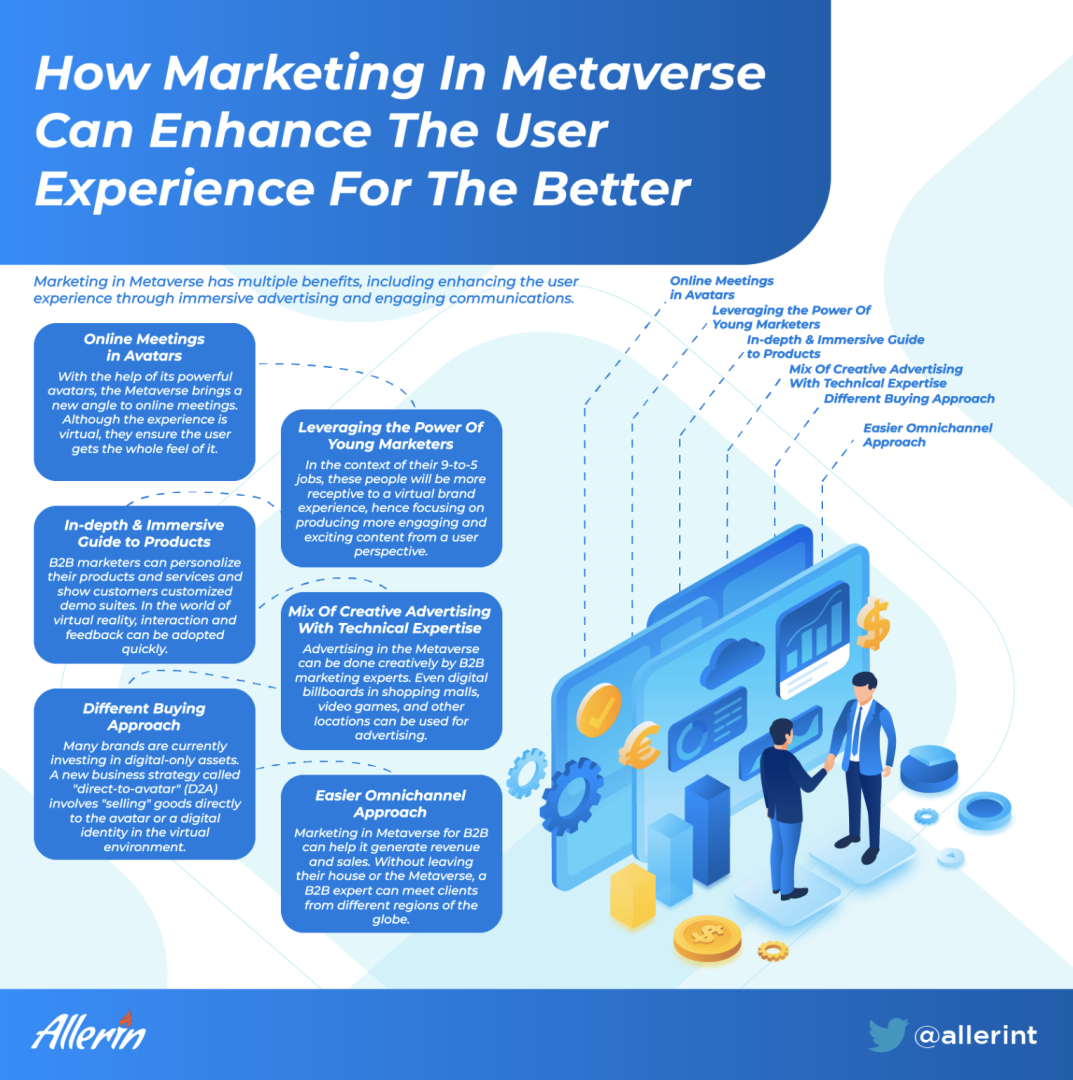TECHNOLOGY
How Marketers Can Enhance User Experience in B2B Marketing With Metaverse

The use of marketing in the metaverse has multiple benefits, including better user experience via immersive advertising and personalized communication.
When asked how businesses are keeping up with the digital transformation, the Metaverse is a standard marketing professional’s response. However, it is highly doubtful that those marketers will feel comfortable defining what marketing in Metaverse actually means for their brand. Over time, the metaverse has been a more prevalent topic of conversation in the business world. Virtual reality (VR), previously considered a medium for making the future concrete through gaming and pleasure, swiftly developed into a viable area for commercial operations, trade, and community building. With every company aspiring to satisfy the needs and demands of its clients, B2B businesses are constantly trying to adopt innovative ways to engage and communicate with their clients. With the Metaverse, even the purchasing process will be transformed. B2B businesses can create the perfect consumer profiles and match them according to the Metaverse. It is the internet’s foreseeable future, with even tech giants like Facebook adopting the name “Meta.” Hence, marketing can be significantly affected by the Metaverse’s emergence.
HOW MARKETING IN THE METAVERSE CAN ENHANCE THE USER EXPERIENCE FOR THE BETTER

The idea of community and engagement is central to the Metaverse. Previously constrained by the expenses of costly business travel and trade events, B2B brands may now electronically communicate and enhance UX through the Metaverse. Let’s dive deeper into this.
1. Online Meetings in Avatars
For any business, communication is its bread and butter. But this communication had a little twist in 2020 when the pandemic hit us. Everyone was forced to resort to online meetings, trying to make the most out of the virtual setting all of us were pushed into. Metaverse is somewhat a step up to that, but just better.
With the help of its powerful avatars, the Metaverse brings a new angle to online meetings. Although the experience is virtual, they ensure the user gets the whole feel of it. Users may design avatars in the Metaverse that mirror or represent them in the physical world. These avatars can engage with each other in 3D virtual conference rooms. This creates an immersive communication experience at industry conferences or simple meetings.
2. Leveraging the Power Of Young Marketers
The Metaverse also serves as a channel for the younger generation of business decision-makers who grew up playing video games and prefer to research and transact through digital media. In the context of their 9-to-5 jobs, these people will be more receptive to a virtual brand experience, hence focusing on producing more engaging and exciting content from a user perspective.
3. In-depth & Immersive Guide to Products
The pandemic taught us that an in-person conversation wasn’t a necessity to close the deals. Metaverse works on the same idea to make the customer experience more immersive.
Customer experience can be recreated with the Metaverse with VR, AR, and scannable texts for B2B marketing since it requires frequent client engagement. B2B marketers can personalize their products and services and show customers customized demo suites. In the world of virtual reality, interaction and feedback can be adopted quickly. Additionally, customers can be contacted at any point in their journey to ensure they are happy with the customer experience, adding a personal touch.
4. Mix Of Creative Advertising With Technical Expertise
The potential benefits of B2B businesses entering the Metaverse cannot be overlooked. The immersive space allows marketers to experiment and showcase different marketing and advertising ventures. With virtual booths and tours, one doesn’t just need to proclaim their product is excellent but can let their people experience it for themselves.
Advertising in the Metaverse can be done creatively by B2B marketing experts. Even digital billboards in shopping malls, video games, and other locations can be used for advertising. This will enable brands to connect with the Metaverse’s millions of users. One may construct virtual items, avatars and interactive games by fusing creative advertising with technical expertise. In the Metaverse, prominent locations where the intended audience assembles can be used for billboard placement.
5. Different Buying Approach
A digital twin is essentially a virtual version of a product or service updated with the use of real-time data. The use of digital twins in manufacturing processes is quite frequent. However, its use has grown to incorporate digital versions of people, places, things, etc., in virtual worlds as Web 3.0 and the metaverse approach.
In order to be used solely by digital avatars in the Metaverse, many brands are currently investing in digital-only assets. A new business strategy called “direct-to-avatar” (D2A) involves “selling” goods directly to the avatar or a digital identity in the virtual environment. The D2A market enables businesses to sell digital twins, including footwear, apparel, purses, spectacles, etc., to the avatars of consumers to use in various virtual environments and video games.
6. Easier Omnichannel Approach
According to the CEO of Bigtincan, David Keane, the Metaverse will enable businesses to put their consumers first as virtual selling environments are eventually becoming the standard. Customers can control their shopping experiences from anywhere at any time thanks to the extended reality technologies like VR and MR that have been added to the Metaverse. Businesses can create a virtual showroom in these environments where customers can interact with images, videos, 3D products and other content. A company may create virtual environments where clients can interact with representatives for a tailored shopping experience. Thanks to these online showrooms, customers can truly comprehend the potential brand and product they are buying.
Marketing in Metaverse for B2B can help it generate revenue and sales. Without leaving their house or the Metaverse, a B2B expert can meet clients from different regions of the globe. They can take advantage of enhanced markets, expanded markets and increased revenue sources. The Metaverse has the potential to replace conventional marketing methods, despite its infancy. The secret to success for marketers has always been to reach the appropriate audience with the right message at the right time. Although it is still developing, the Metaverse puts an entirely new spin on marketing strategies, and both businesses and consumers are eager to discover what opportunities it opens up.
TECHNOLOGY
Next-gen chips, Amazon Q, and speedy S3

AWS re:Invent, which has been taking place from November 27 and runs to December 1, has had its usual plethora of announcements: a total of 21 at time of print.
Perhaps not surprisingly, given the huge potential impact of generative AI – ChatGPT officially turns one year old today – a lot of focus has been on the AI side for AWS’ announcements, including a major partnership inked with NVIDIA across infrastructure, software, and services.
Yet there has been plenty more announced at the Las Vegas jamboree besides. Here, CloudTech rounds up the best of the rest:
Next-generation chips
This was the other major AI-focused announcement at re:Invent: the launch of two new chips, AWS Graviton4 and AWS Trainium2, for training and running AI and machine learning (ML) models, among other customer workloads. Graviton4 shapes up against its predecessor with 30% better compute performance, 50% more cores and 75% more memory bandwidth, while Trainium2 delivers up to four times faster training than before and will be able to be deployed in EC2 UltraClusters of up to 100,000 chips.
The EC2 UltraClusters are designed to ‘deliver the highest performance, most energy efficient AI model training infrastructure in the cloud’, as AWS puts it. With it, customers will be able to train large language models in ‘a fraction of the time’, as well as double energy efficiency.
As ever, AWS offers customers who are already utilising these tools. Databricks, Epic and SAP are among the companies cited as using the new AWS-designed chips.
Zero-ETL integrations
AWS announced new Amazon Aurora PostgreSQL, Amazon DynamoDB, and Amazon Relational Database Services (Amazon RDS) for MySQL integrations with Amazon Redshift, AWS’ cloud data warehouse. The zero-ETL integrations – eliminating the need to build ETL (extract, transform, load) data pipelines – make it easier to connect and analyse transactional data across various relational and non-relational databases in Amazon Redshift.
A simple example of how zero-ETL functions can be seen is in a hypothetical company which stores transactional data – time of transaction, items bought, where the transaction occurred – in a relational database, but use another analytics tool to analyse data in a non-relational database. To connect it all up, companies would previously have to construct ETL data pipelines which are a time and money sink.
The latest integrations “build on AWS’s zero-ETL foundation… so customers can quickly and easily connect all of their data, no matter where it lives,” the company said.
Amazon S3 Express One Zone
AWS announced the general availability of Amazon S3 Express One Zone, a new storage class purpose-built for customers’ most frequently-accessed data. Data access speed is up to 10 times faster and request costs up to 50% lower than standard S3. Companies can also opt to collocate their Amazon S3 Express One Zone data in the same availability zone as their compute resources.
Companies and partners who are using Amazon S3 Express One Zone include ChaosSearch, Cloudera, and Pinterest.
Amazon Q
A new product, and an interesting pivot, again with generative AI at its core. Amazon Q was announced as a ‘new type of generative AI-powered assistant’ which can be tailored to a customer’s business. “Customers can get fast, relevant answers to pressing questions, generate content, and take actions – all informed by a customer’s information repositories, code, and enterprise systems,” AWS added. The service also can assist companies building on AWS, as well as companies using AWS applications for business intelligence, contact centres, and supply chain management.
Customers cited as early adopters include Accenture, BMW and Wunderkind.
Want to learn more about cybersecurity and the cloud from industry leaders? Check out Cyber Security & Cloud Expo taking place in Amsterdam, California, and London. Explore other upcoming enterprise technology events and webinars powered by TechForge here.
TECHNOLOGY
HCLTech and Cisco create collaborative hybrid workplaces

Digital comms specialist Cisco and global tech firm HCLTech have teamed up to launch Meeting-Rooms-as-a-Service (MRaaS).
Available on a subscription model, this solution modernises legacy meeting rooms and enables users to join meetings from any meeting solution provider using Webex devices.
The MRaaS solution helps enterprises simplify the design, implementation and maintenance of integrated meeting rooms, enabling seamless collaboration for their globally distributed hybrid workforces.
Rakshit Ghura, senior VP and Global head of digital workplace services, HCLTech, said: “MRaaS combines our consulting and managed services expertise with Cisco’s proficiency in Webex devices to change the way employees conceptualise, organise and interact in a collaborative environment for a modern hybrid work model.
“The common vision of our partnership is to elevate the collaboration experience at work and drive productivity through modern meeting rooms.”
Alexandra Zagury, VP of partner managed and as-a-Service Sales at Cisco, said: “Our partnership with HCLTech helps our clients transform their offices through cost-effective managed services that support the ongoing evolution of workspaces.
“As we reimagine the modern office, we are making it easier to support collaboration and productivity among workers, whether they are in the office or elsewhere.”
Cisco’s Webex collaboration devices harness the power of artificial intelligence to offer intuitive, seamless collaboration experiences, enabling meeting rooms with smart features such as meeting zones, intelligent people framing, optimised attendee audio and background noise removal, among others.
Want to learn more about cybersecurity and the cloud from industry leaders? Check out Cyber Security & Cloud Expo taking place in Amsterdam, California, and London. Explore other upcoming enterprise technology events and webinars powered by TechForge here.
TECHNOLOGY
Canonical releases low-touch private cloud MicroCloud

Canonical has announced the general availability of MicroCloud, a low-touch, open source cloud solution. MicroCloud is part of Canonical’s growing cloud infrastructure portfolio.
It is purpose-built for scalable clusters and edge deployments for all types of enterprises. It is designed with simplicity, security and automation in mind, minimising the time and effort to both deploy and maintain it. Conveniently, enterprise support for MicroCloud is offered as part of Canonical’s Ubuntu Pro subscription, with several support tiers available, and priced per node.
MicroClouds are optimised for repeatable and reliable remote deployments. A single command initiates the orchestration and clustering of various components with minimal involvement by the user, resulting in a fully functional cloud within minutes. This simplified deployment process significantly reduces the barrier to entry, putting a production-grade cloud at everyone’s fingertips.
Juan Manuel Ventura, head of architectures & technologies at Spindox, said: “Cloud computing is not only about technology, it’s the beating heart of any modern industrial transformation, driving agility and innovation. Our mission is to provide our customers with the most effective ways to innovate and bring value; having a complexity-free cloud infrastructure is one important piece of that puzzle. With MicroCloud, the focus shifts away from struggling with cloud operations to solving real business challenges” says
In addition to seamless deployment, MicroCloud prioritises security and ease of maintenance. All MicroCloud components are built with strict confinement for increased security, with over-the-air transactional updates that preserve data and roll back on errors automatically. Upgrades to newer versions are handled automatically and without downtime, with the mechanisms to hold or schedule them as needed.
With this approach, MicroCloud caters to both on-premise clouds but also edge deployments at remote locations, allowing organisations to use the same infrastructure primitives and services wherever they are needed. It is suitable for business-in-branch office locations or industrial use inside a factory, as well as distributed locations where the focus is on replicability and unattended operations.
Cedric Gegout, VP of product at Canonical, said: “As data becomes more distributed, the infrastructure has to follow. Cloud computing is now distributed, spanning across data centres, far and near edge computing appliances. MicroCloud is our answer to that.
“By packaging known infrastructure primitives in a portable and unattended way, we are delivering a simpler, more prescriptive cloud experience that makes zero-ops a reality for many Industries.“
MicroCloud’s lightweight architecture makes it usable on both commodity and high-end hardware, with several ways to further reduce its footprint depending on your workload needs. In addition to the standard Ubuntu Server or Desktop, MicroClouds can be run on Ubuntu Core – a lightweight OS optimised for the edge. With Ubuntu Core, MicroClouds are a perfect solution for far-edge locations with limited computing capabilities. Users can choose to run their workloads using Kubernetes or via system containers. System containers based on LXD behave similarly to traditional VMs but consume fewer resources while providing bare-metal performance.
Coupled with Canonical’s Ubuntu Pro + Support subscription, MicroCloud users can benefit from an enterprise-grade open source cloud solution that is fully supported and with better economics. An Ubuntu Pro subscription offers security maintenance for the broadest collection of open-source software available from a single vendor today. It covers over 30k packages with a consistent security maintenance commitment, and additional features such as kernel livepatch, systems management at scale, certified compliance and hardening profiles enabling easy adoption for enterprises. With per-node pricing and no hidden fees, customers can rest assured that their environment is secure and supported without the expensive price tag typically associated with cloud solutions.
Want to learn more about cybersecurity and the cloud from industry leaders? Check out Cyber Security & Cloud Expo taking place in Amsterdam, California, and London. Explore other upcoming enterprise technology events and webinars powered by TechForge here.
-

 PPC6 days ago
PPC6 days ago19 Best SEO Tools in 2024 (For Every Use Case)
-

 MARKETING7 days ago
MARKETING7 days agoEcommerce evolution: Blurring the lines between B2B and B2C
-
SEARCHENGINES5 days ago
Daily Search Forum Recap: April 19, 2024
-
SEARCHENGINES6 days ago
Daily Search Forum Recap: April 18, 2024
-

 WORDPRESS6 days ago
WORDPRESS6 days agoHow to Make $5000 of Passive Income Every Month in WordPress
-

 SEO7 days ago
SEO7 days ago2024 WordPress Vulnerability Report Shows Errors Sites Keep Making
-

 WORDPRESS7 days ago
WORDPRESS7 days ago10 Amazing WordPress Design Resouces – WordPress.com News
-

 SEO6 days ago
SEO6 days ago25 WordPress Alternatives Best For SEO
















You must be logged in to post a comment Login